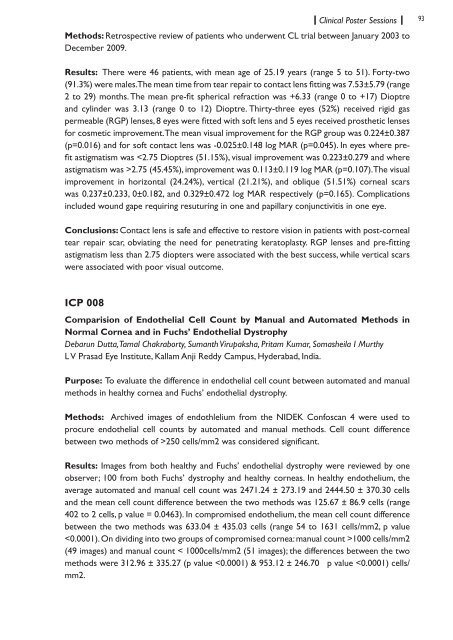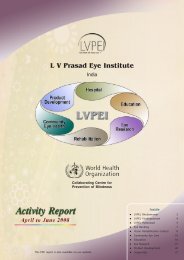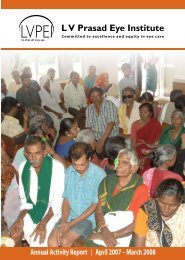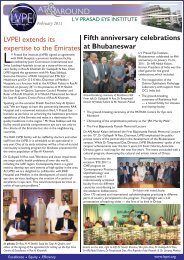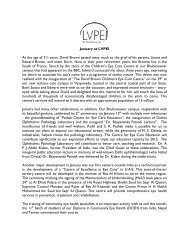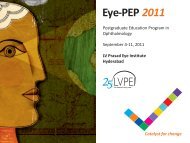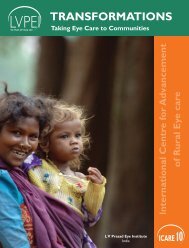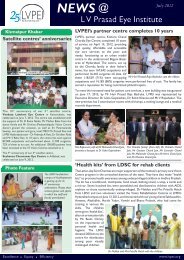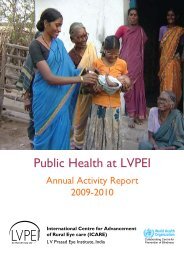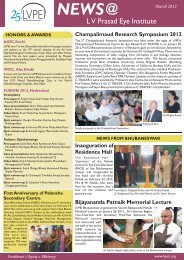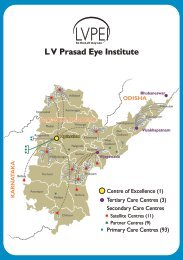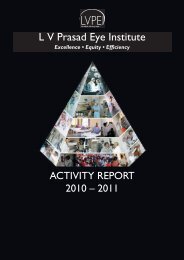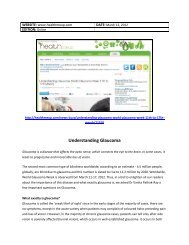IERG Abstracrt Book.indd - LV Prasad Eye Institute
IERG Abstracrt Book.indd - LV Prasad Eye Institute
IERG Abstracrt Book.indd - LV Prasad Eye Institute
You also want an ePaper? Increase the reach of your titles
YUMPU automatically turns print PDFs into web optimized ePapers that Google loves.
Clinical Poster SessionsMethods: Retrospective review of patients who underwent CL trial between January 2003 toDecember 2009.93Results: There were 46 patients, with mean age of 25.19 years (range 5 to 51). Forty-two(91.3%) were males. The mean time from tear repair to contact lens fitting was 7.53±5.79 (range2 to 29) months. The mean pre-fit spherical refraction was +6.33 (range 0 to +17) Dioptreand cylinder was 3.13 (range 0 to 12) Dioptre. Thirty-three eyes (52%) received rigid gaspermeable (RGP) lenses, 8 eyes were fitted with soft lens and 5 eyes received prosthetic lensesfor cosmetic improvement. The mean visual improvement for the RGP group was 0.224±0.387(p=0.016) and for soft contact lens was -0.025±0.148 log MAR (p=0.045). In eyes where prefitastigmatism was 2.75 (45.45%), improvement was 0.113±0.119 log MAR (p=0.107). The visualimprovement in horizontal (24.24%), vertical (21.21%), and oblique (51.51%) corneal scarswas 0.237±0.233, 0±0.182, and 0.329±0.472 log MAR respectively (p=0.165). Complicationsincluded wound gape requiring resuturing in one and papillary conjunctivitis in one eye.Conclusions: Contact lens is safe and effective to restore vision in patients with post-cornealtear repair scar, obviating the need for penetrating keratoplasty. RGP lenses and pre-fittingastigmatism less than 2.75 diopters were associated with the best success, while vertical scarswere associated with poor visual outcome.ICP 008Comparision of Endothelial Cell Count by Manual and Automated Methods inNormal Cornea and in Fuchs’ Endothelial DystrophyDebarun Dutta, Tamal Chakraborty, Sumanth Virupaksha, Pritam Kumar, Somasheila I MurthyL V <strong>Prasad</strong> <strong>Eye</strong> <strong>Institute</strong>, Kallam Anji Reddy Campus, Hyderabad, India.Purpose: To evaluate the difference in endothelial cell count between automated and manualmethods in healthy cornea and Fuchs’ endothelial dystrophy.Methods: Archived images of endothlelium from the NIDEK Confoscan 4 were used toprocure endothelial cell counts by automated and manual methods. Cell count differencebetween two methods of >250 cells/mm2 was considered significant.Results: Images from both healthy and Fuchs’ endothelial dystrophy were reviewed by oneobserver; 100 from both Fuchs’ dystrophy and healthy corneas. In healthy endothelium, theaverage automated and manual cell count was 2471.24 ± 273.19 and 2444.50 ± 370.30 cellsand the mean cell count difference between the two methods was 125.67 ± 86.9 cells (range402 to 2 cells, p value = 0.0463). In compromised endothelium, the mean cell count differencebetween the two methods was 633.04 ± 435.03 cells (range 54 to 1631 cells/mm2, p value1000 cells/mm2(49 images) and manual count < 1000cells/mm2 (51 images); the differences between the twomethods were 312.96 ± 335.27 (p value


